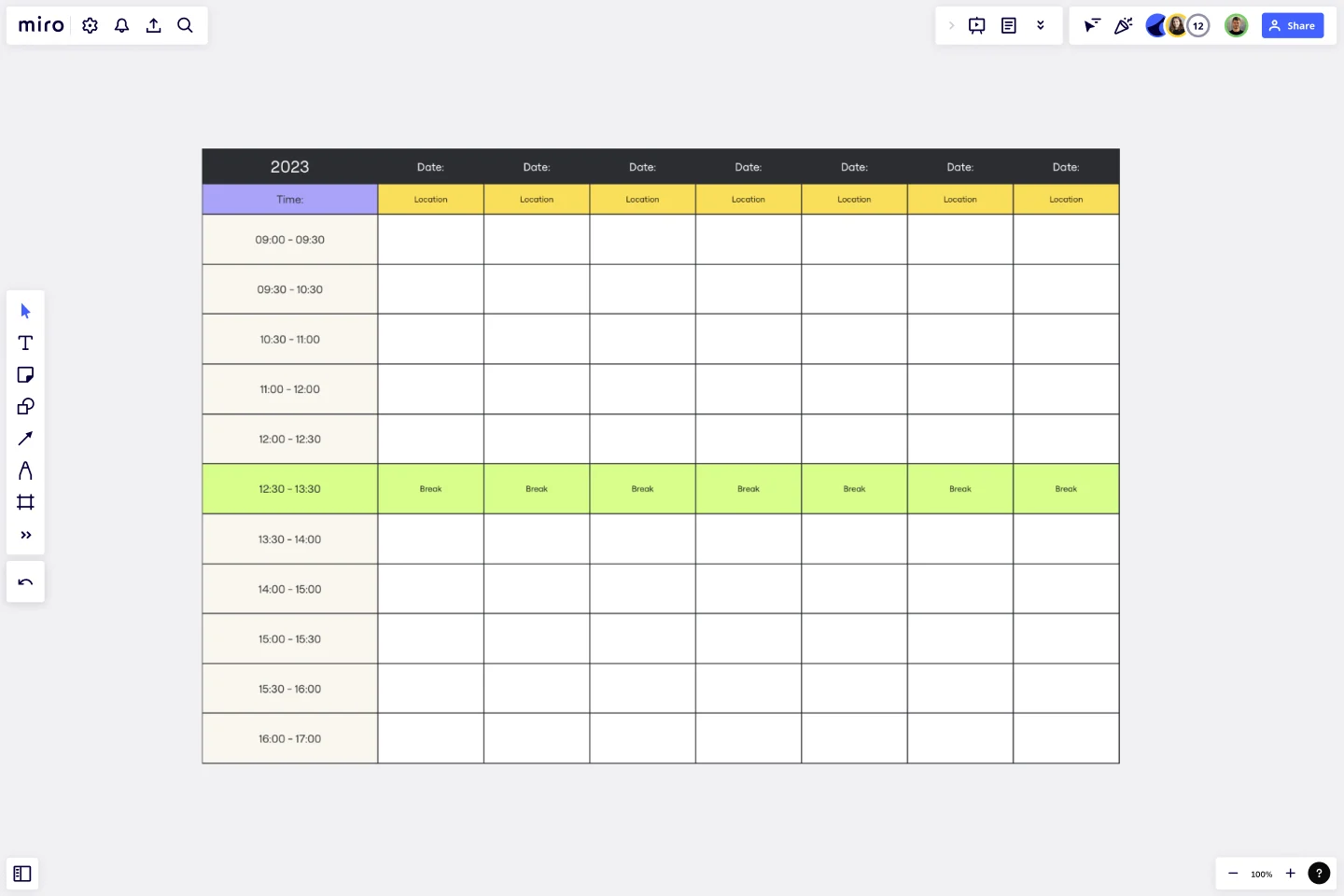Schedule Template
Streamline your time management with the schedule template.
Trusted by 65M+ users and leading companies
About the Schedule Template
Scheduling is the backbone of many successful projects, events, and daily routines. Whether you're mapping out a conference, planning a project timeline, or simply organizing your week, a visual representation can make all the difference. Enter the schedule template, a universal tool to simplify your time management process.
What's a schedule template?
A schedule template is a pre-formatted visual layout that allows users to plot out time-specific events, tasks, or activities over a set duration. It's akin to a calendar or planner but is often more flexible, allowing for customization based on specific needs or projects.
How to use the schedule template in Miro
Follow these simple steps to use the schedule template effectively:
Edit time slots: Click on any time slot you wish to change. You can adjust the duration or rename it with just a few clicks.
Adjust the overall timeframe: If you need a broader or narrower view, change the timeframe to reflect days, weeks, or even months.
Add specific events: Click on the desired slot and input the event, task, or activity you wish to schedule.
Integrate other documents: Drag and drop any artifact to your board, such as images, links, or any other documentation, when needed.
Color-code and customize: Use different colors to categorize or prioritize various events or tasks for added clarity.
Save and share: Once your schedule is tailored to your needs, save it and share it with your team for seamless collaboration.
Why should you use a schedule template?
Efficiency: A visual layout enables quicker planning and adjustments, saving time in the long run.
Clarity: A well-organized template provides a clear overview of tasks, reducing the risk of overlaps or missed appointments.
Flexibility: Adjust the template to fit various timeframes, whether a week, a month, or a custom duration.
Collaboration: Sharing the schedule allows teams to align, ensuring everyone is on the same page.
Customization: Beyond time management, you can integrate other docs and visual elements to provide context or enhance understanding.
Can I adjust the time intervals on the template?
Absolutely. The template is designed to be adaptable, allowing users to customize the intervals per their needs.
Is it possible to color-code events or tasks?
Yes, color-coding is an option to visually categorize or prioritize different events, making the schedule even more intuitive.
How can I share my schedule with others?
Sharing is easy. Once your schedule is set, you can provide access to anyone, enabling seamless collaboration by sharing your board link.
Are there options for recurring events or tasks?
While the template allows individual event input, users can easily replicate or duplicate events to indicate recurrences.
Get started with this template right now.
Work Plan Template
Works best for:
Mapping, Project Planning
A work plan is essentially a roadmap for a project. It articulates the steps you must take to achieve the desired goal, sets demonstrable objectives, and establishes measurable deliverables. An effective work plan guides you throughout the project lifecycle, allowing you to realize an outcome by collaborating with your team. Although work plans vary, they generally contain four core components: goals, strategy, tactics, and deliverables.
Workflow Template
Works best for:
Project Management, Workflows
The digital world requires collaboration, and better collaboration leads to better results. A workflow is a project management tool that allows you to sketch out the various steps, resources, timeline and roles necessary to complete a project. It can be used on any multi-step project, whether it’s a business process or otherwise, and is ideal for plotting out the tangible actions you’ll need to take to achieve a goal and the order in which you need to complete those actions.
Outcome Mapping Template
Works best for:
Diagrams, Mapping, Project Management
Use Miro’s outcome mapping template to improve your operational efficiency. Outcome mapping will help you visualize all the possible strategic outcomes for your upcoming project, allowing you to see into the black box to identify any potential challenges along the way.
Change Control Process Template
Works best for:
Agile Methodology, Documentation, Product Management
You can predict, research, and plan for every detail of a project to go a certain way—then along comes the unforeseen and modifications are needed. That’s when a change control process comes into play. It helps define the right steps to take, gives stakeholders full visibility, and reduces the chances of errors and disruption. And this template is easy to use and highly effective—for ensuring that proposed changes are reviewed before they’re implemented, and empowering teams to veto changes that might prove unnecessary or disruptive.
Risk Assessment Template
Works best for:
Leadership, Project Management, Decision Making
Every business faces risk. The more you factor it into your decisions early on, the better prepared you’ll be to avoid, absorb, or mitigate the risks you encounter. Use Miro’s risk assessment template to collaborate on a clear-eyed risk assessment that ensures you’ll never be caught unawares.
Flowchart Template
Works best for:
Flowcharts, Mapping, Diagrams
Trying to explain a process or workflow to your team — or just wrap your head around it yourself? Sometimes the best way is to see it, and that’s when you create a flowchart. Using common shapes (generally just ovals, rectangles, diamonds, and arrows), a flowchart shows you the direction a process or workflow goes and the order of steps. Beyond giving you a clear understanding, you’ll also be able to see potential flaws and bottlenecks, which helps you refine and improve your process and create a better product more efficiently.
